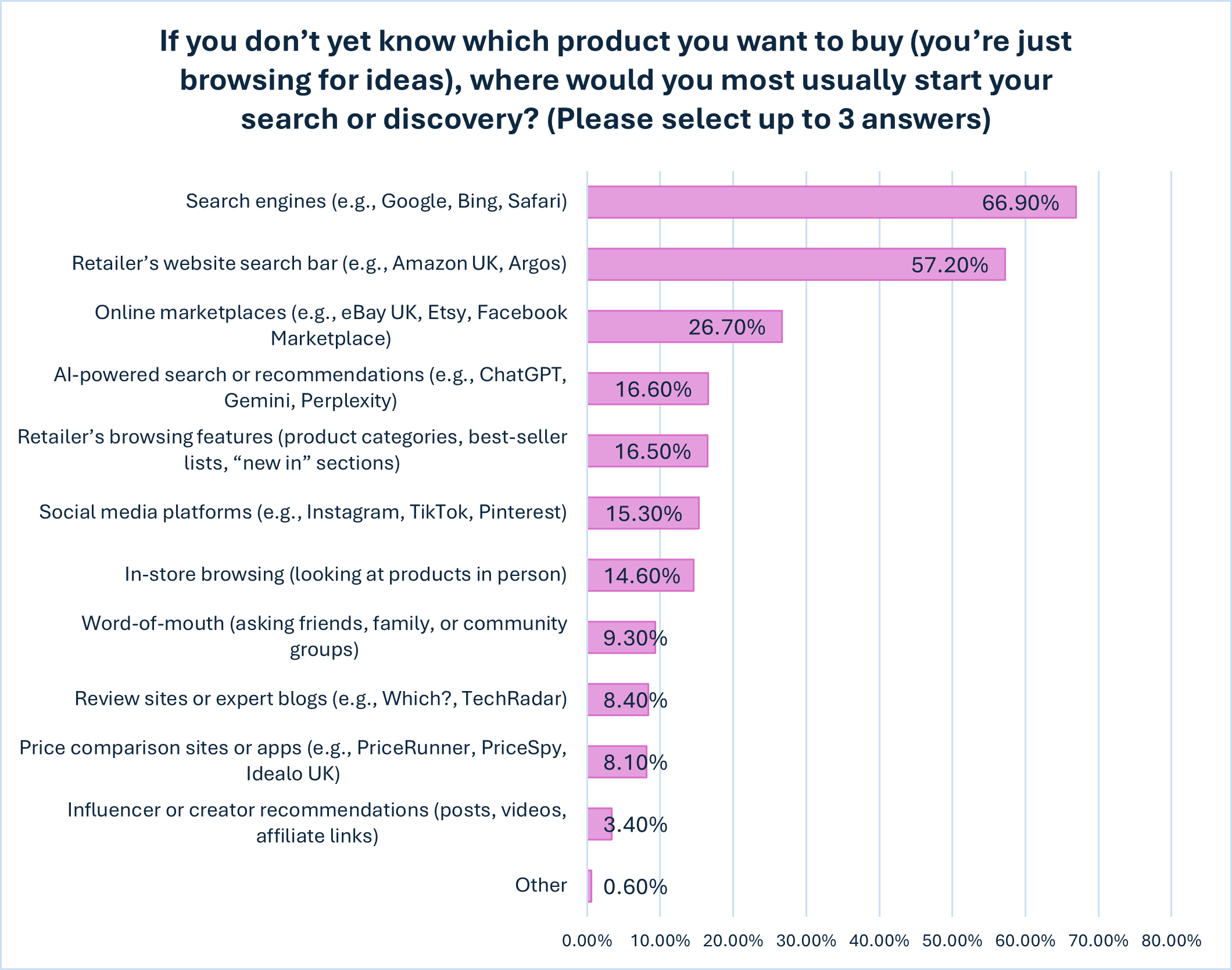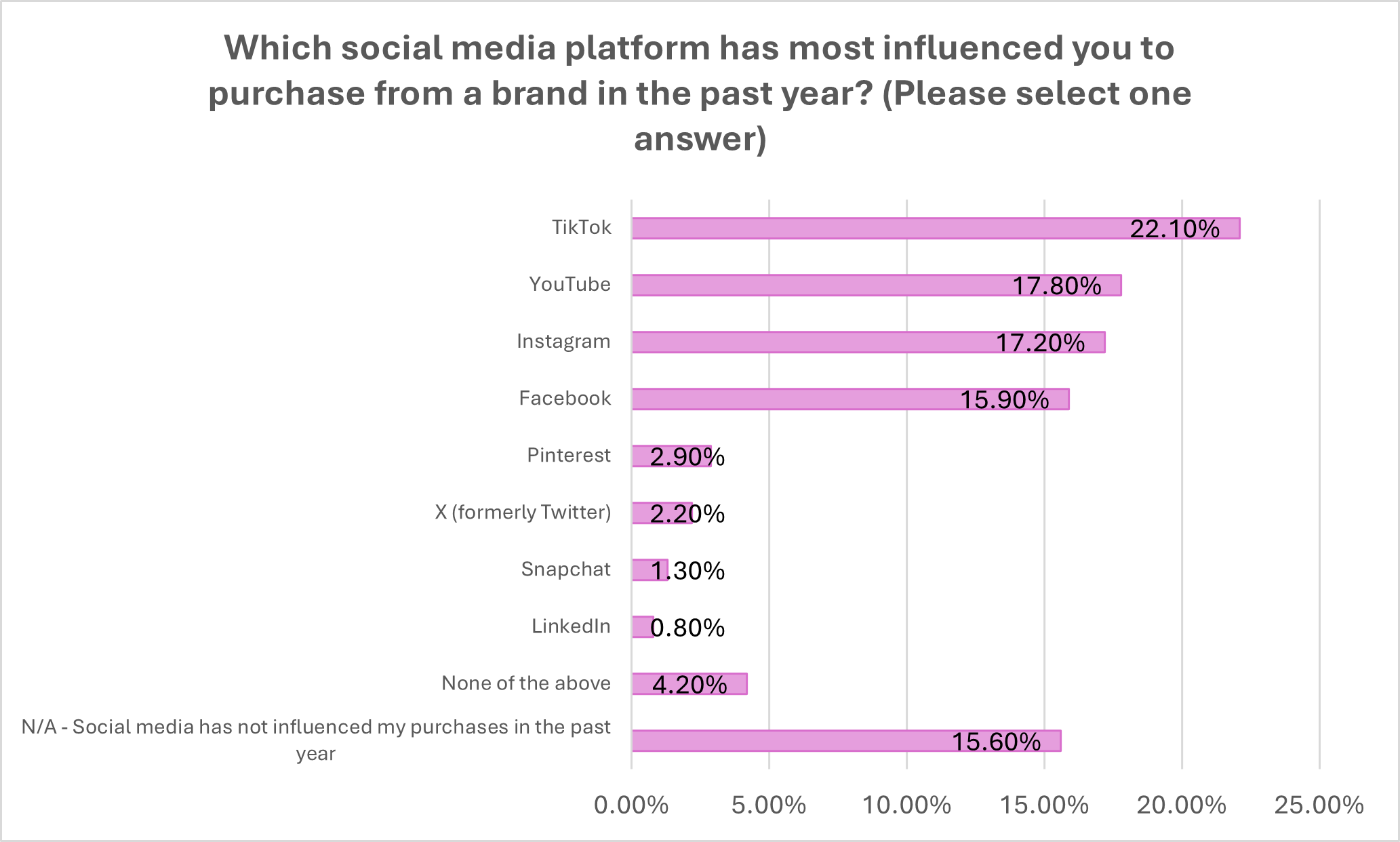By Ellie-Rose Davies, Content Executive at IMRG
Helping customers find what they didn’t know they needed can be as valuable as helping them buy what they came for.
In this blog, we explore how retailers can enhance product discovery, from optimising search and social channels to refining presentation, recommendations, and promotions — to capture intent and drive conversion.
Read on for insights into how retailers are:
- Optimising search to capture intent
- Leveraging social to build awareness
- Using presentation and recommendations to drive conversion
- Applying promotions to boost visibility and loyalty
Optimising search to capture intent
When it comes to product discovery, search remains the starting point for most consumers. Whether it’s a Google query, a website search bar, or a marketplace filter, each touchpoint offers retailers a chance to meet customers with precision and intent.

When a consumer does not know exactly what they want to buy, search is the natural first step.
According to our recent research with Feedonomics, the most common starting points for product search are ‘search engines’ (selected by 66.9% of 1,000 UK respondents), followed by a retailer’s own ‘website search bar’ (57.2%), and ‘online marketplaces’ (26.7%).
Andra Muntean, Senior Marketing Manager EMEA at Athos Commerce shares that ‘Great discovery is about relevance.’
‘Search should handle typos and natural-language queries, recommendations should feel useful, and feeds should be optimised for Google, marketplaces, and AI platforms.’
Andra continues, ‘Done well, this reduces bounce and lifts AOV. For example, retailers who tailor cross-sells by category make can make shopping easier, while generic “trending” products may often feel intrusive.’
Andra shares that ‘A common mistake is confusing discovery with distraction. Forcing unrelated items into results breaks trust.’
‘The goal should be simple: make it effortless for customers to find what they came for and uncover products they did not know they wanted.’
Simon Dyer, Regional Vice President, UK & Nordics at Mirakl shares his tips for retailers looking to improve search and discovery on their site. He says:
‘Effective product discovery starts with clean, consistent data. When titles and attributes align to a sensible taxonomy, filters and search can guide shoppers quickly to the right options.’
‘Confidence follows with clear imagery, size and compatibility cues, reviews and results that favour items in stock and fast to deliver. Key shopping moments — Black Friday, back-to-school, holiday gifting — become curated entry points that surface the most relevant assortment, not detours.’
From Alexander Otto, Head of Corporate Relations at Tradebyte provides tips for improving search and discoverability through marketplaces.
Marketplaces have shown to be a top way consumers discover products, especially when they already know what they want to buy.
Alexander says, ‘Over 50% of product searches in Europe start directly on Amazon rather than on a search engine like Google, according to Statista, while third-party sales through online marketplaces are projected to account for around 59% of all global eCommerce by 2027.’
‘This trend is particularly strong in Europe, where marketplaces like Amazon, Zalando, and About You dominate.’
‘A common mistake we see is applying a one-size-fits-all approach. Brands can tailor their strategies to each marketplace platform’s unique ranking criteria, ensuring accuracy, engaging imagery, and detailed attributes that build trust and reduce returns.’
By blending retail media with performance marketing and platform-specific optimisation, brands can move from being seen to being chosen, ultimately driving both conversion and long-term loyalty,’ says Alexander.
Leveraging social to build awareness
Social media has evolved from a place for connection alone to a powerful engine for inspiration and discovery. It’s where many consumers turn to see products in action, hear authentic voices, and make confident purchase decisions based on real experiences.
Reflecting on the power of social media are Genie Goal’s Gisela Benini, Client Strategy Director, and Hannah Hooton, Head of Partnerships + Marketing.
Gisela exclaims, ‘If creative is the new targeting, use it wisely.’
‘On social, video is king because it shows how a product fits into someone’s life. The key question isn’t “How do I show the product?” but “Am I speaking to my audience?”’
Gisela notes how ‘Leading with “Meet our [product]” often just reaches people who already know you. For true new-customer growth, you can flip the script: focus on your audience’s needs and speak their language.’
‘Bonus tip, whitelist ads through trusted creators. Their authentic voice builds trust, extends reach, and sparks discovery, making it easier to win attention and new buyers.’
Hannah also speaks to the value of video and social media. She says, ‘On YouTube, consumers are twice as likely to discover new products compared to other platforms, and Demand Gen helps turn that discovery into action.’
‘Brands can use video to show products in real-life contexts, keeping creative simple, engaging, and audience-first.’
Hannah recommends for retailers to ‘Start in October, when CPMs are lower, to build consideration ahead of Peak.’
‘Pair YouTube video with Demand Gen and Performance Max to capture attention early, then convert efficiently when demand surges. Discovery done right means stronger sales later.’

What is interesting is that YouTube ranked the second most popular social media platform that most influenced customers to purchase from a brand in the past year, showing it to be a great channel to utilise for product discovery efforts.
Using presentation and recommendations to drive conversion
Helping consumers discover products that genuinely match their interests is one of the most effective ways to drive conversion, especially as retailers compete for attention in the run-up to Peak trading season.
Experts at Tapestry reflect on the need to make the discovery experience relevant for every consumer, saying, ‘Retailers can move beyond knowing what customers buy, to understanding what those purchases reveal about their future potential.’
‘By creating a single customer view, retailers can uncover how cross-category and sequential product purchase behaviours signal intent, interests, and long-term value.’
‘This depth of insight enables retailers to design product journeys that nurture engagement, presenting the next most relevant product at the moment it’s most likely to resonate.’
Tapestry says, ‘Crucially, by linking product discovery to lifetime value, retailers can focus on categories that build loyalty and profitability, turning product exploration into lasting customer relationships.’
Industry experts at Prisync also note the importance of how merchants present their products, ‘whether on mobile or desktop, and how this can significantly impact customers’ purchasing decisions.’
They say, ‘Designing intuitive and fast websites where price information, product descriptions, reviews, and images are clear and organised can keep customers’ attention once they arrive.’
‘The display of carefully prepared psychological pricing tactics and personalised product suggestions can also nudge them to complete their purchase.’
Prisync note that ‘If not, one thing is for sure: if someone has searched for a product once and left their cart, they will keep seeing similar products for the rest of their screen time, whether they are reading news or scrolling through Instagram.’
‘That’s where using targeted ads can help capitalise on gaps where your competitors fall short.’
‘One tactic could be to utilise ads to display specifically chosen products that can lure customers into your store, then ultimately present them with better or complementary options to increase revenue through upselling and cross-selling.’
Moe Dhanji, Key Account Director at Commerce highlights the importance of optimising product pages and feeds.
He shares that ‘As Peak 2025 looms, retailers can sharpen their product feeds now—optimise titles, descriptions, images and all relevant attributes with gift‑friendly keywords to capture seasonal demand.’
‘Ensure feeds are resilient: robust data governance, frequent feed testing, and automated alerts will prevent the kinds of disruptions that can cost you during Black Friday and Christmas.’
Moe shares that ‘Inventory buffers or real‑time syncs can be great to avoid stockouts or overselling.’ And finally, he urges retailers to ‘customise ad campaigns using labels for bestsellers, high‑margin lines or holiday promos so their most strategic SKUs shine.’
Applying promotions to boost visibility and loyalty
Promotions have multiple use cases including sparking discovery. Smartly targeted discounts and incentives can introduce customers to new products, recover missed opportunities, and turn out-of-stock frustration into fresh engagement.
Dan Bond, VP Marketing at RevLifter explores this in detail, saying ‘Product discovery isn’t about showing customers everything – it’s about showing them the right thing at the right moment.’
‘Savvy retailers use onsite promotions to guide discovery. When someone views a product but hesitates, retailers can show similar items with better availability.’
Dan recommends that ‘If they’re browsing without buying, surface best-sellers with incentives.’
‘When products go out of stock, disappointment can turn into discovery. Retailers can recommend alternatives with promotions that make switching worthwhile.’
Dan continues, ‘Many retailers think discovery happens before promotion. In reality, they work together. Your strategy can highlight products needing discovery while protecting margins on items customers already want.’
‘Discovery and profitability aren’t opposing forces – they’re partners.’
The insights from this blog demonstrate how through optimising search and social to refining presentation and promotions, each channel plays an important role in helping consumers find products that suit them. The key theme across our findings is relevance, helping to ensure every touchpoint feels intuitive, personalised, and consistent.
Want to read more? Here are some other IMRG blogs that may take your interest:
Preparing for Peak 2025: Tips to help retailers prepare – IMRG
The Overlooked 20% Advantage for Google Shopping Ads – IMRG
Agentic commerce is coming. Are your fraud and checkout systems ready? – IMRG
Getting BOPIS right: Key tactics for operational excellence – IMRG
The power of timing in retail promotions – IMRG
Published 09/10/2025


